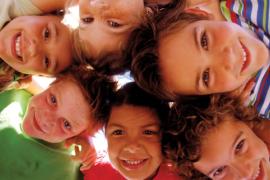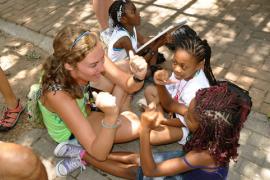This column is different from what I usually provide. It poses a vision for the future of our camp community’s health profile. As you read, ask if the ideas reflect your desire for improving our health profile, improvement that has the potential to impact both your camp’s initiatives as well as our national profile. The content flows from the United States’ framework for Healthy People 2030. I’ve modified it for the camp community in an effort to help guide health promotion efforts for the American Camp Association (ACA), Association of Camp Nursing (ACN), as well as individual camps through the Healthy Camps initiative. Healthy Camp People 2030 links the health promotion initiatives of our US camp community with the national health agenda, strengthening our alignment with the external community and improving the camp experience for campers, seasonal staff, and camp professionals, as well as remaining sensitive to organizational initiatives of ACA and ACN.
Healthy Camp People 2030 is the second iteration of health objectives for the US camp community. The first objectives were developed in 2009 to complement Healthy People 2020 and brought the camp community into the national Healthy People initiative. With this historic base, we now have opportunity to be forward-thinking and innovative by again linking our health initiatives to those of the greater US population. Doing so provides us with benchmarked health goals to use in research, program development, and health outcomes assessment.
Our soon-to-be-released, camp-specific objectives for 2030 — which will debut at the 2020 ACA National Conference — will build on what has been learned the past 10 years. Specifically, the objectives will focus on reducing preventable illness and injury and more deeply incorporate mental, emotional, and social health (MESH) into the fabric of the camp community. Ambitious, quantifiable objectives to improve our national camp health profile and reduce the negative impact of disease, injury, and MESH incidents will be described. These objectives have the potential to guide decisions camp professionals make on a day-to-day basis and are championed by the Healthy Camps initiative, a collaboration between ACA and ACN, and reflected in ACA’s 2020–2024 Strategic Plan.
What Might Healthy Camp People Contribute?
The US Healthy Camp People priorities include those aspects of health most critical to our overall well-being and which can be improved using available knowledge. Healthy Camp People objectives may well shape our health priorities but do not necessarily limit them. Because it’s linked to the US’s Healthy People initiative, Healthy Camp People will help us monitor and assess data about changes in the health status of the US camp population. These data points, in turn, have potential to inform individual goals and objectives.
In so doing, the initiative reflects the common ground between ACA’s Strategic Plan and the ACN’s mission. For example and as currently conceptualized by ACA’s Strategic Plan, Healthy Camp People 2030 objectives have the potential to:
- Address health disparities, improve our diversity, and support greater inclusion efforts among our campers and staff (i.e., address equitable access)
- Demonstrate the camp community’s commitment to youth development by supporting and utilizing health-promoting strategies
- Provide demonstrable health outcomes that last through the lives of campers, seasonal staff, and camp professionals
- Strategically address health disparities and challenges through evidence-based practices that use appropriate benchmarks to monitor progress
- Contribute to society’s greater good by sharing our health stories, research, and outcomes data
While organizational initiatives are great, individual camp communities across the US may also adopt Healthy Camp People goals and objectives. Flexibility is built into the Healthy Camp People 2030 objectives, so each camp community may alter the goals and objectives to meet their needs, and/or use them to set priorities for their region and/or population groups.
What Did Healthy Camp People 2020 Achieve?
Think back over the past 10 years. Since the Healthy People initiative was first launched, the US has made significant progress in its national health profile. Achievements include reducing major causes of death such as heart disease and cancer; reducing risk factors like tobacco smoking, hypertension, and elevated cholesterol; and increasing childhood vaccinations. During the decade, the importance of collaborating across agencies at the national, state, local, and tribal levels, as well as within the private and public health sectors, was demonstrated.
Healthy Camp People 2020 built on this and was a decade in which the efforts of countless camp professionals, staff, and campers improved the health profile of the camp experience. Our achievements include:
- Expanded collection and processing of injury-illness data
- Development of educational resources focused on camp health promotion
- Camp-specific content for Mental Health First Aid courses coupled with a growing number of camp professionals with this credential
- Resources that support the mental, emotional, and social aspects of the camp experience
- Expanded technological supports for camp health initiatives
- Expanded understanding of the scope of health services provided by a given camp
- Increased inclusivity and cultural diversification within camps coupled with increased sensitivity to health issues associated with these areas
- Meeting, if not surpassing, several national Healthy People objectives
Key to these was a widely accessible plan of achievable goals and objectives that guided the action of individuals, communities, and stakeholders who strove to improve the camp health profile, something championed by the Healthy Camps initiative.
As we look to the future, Healthy Camp People 2030 objectives recognize that:
- It’s essential to involve as active partners diverse stakeholders from across public, private, and nonprofit sectors. This is a guiding principle that influences appointments to the Healthy Camps Steering Committee.
- It is important to monitor progress on Healthy Camp People goals and objectives, and to share high-quality data and feedback on progress with camp professionals, other stakeholders, and the general (noncamp) public.
- Significant changes (e.g., reduced injury-illness rates and improved access to quality health care) may be challenging but are achievable through persistent effort.
What Does Our Opportunity — Our Future — Look Like?
Although much progress has been made, the United States lags behind other developed countries on measures of health and well-being including life expectancy, infant mortality, and obesity. That’s despite spending the highest percentage of its gross domestic product on health. Consequently, a challenge for Healthy Camp People 2030 is to guide the camp community in achieving the camp population’s potential for health and well-being in a way that “sticks” as participants continue through their lives, and do so in a cost-effective, resource-sensitive manner.
Toward that end, the Healthy Camp People 2030 objectives will promote an environment in which everyone in the camp community can achieve their full potential for health and well-being and maintain that throughout their lives. We may not fully achieve this in the next 10 years, but we’ll improve. And that’s worth the effort. The principles undergirding this big-picture thinking include elements like these:
- Health and well-being of all people and communities are essential to a thriving, equitable society.
- Promoting health and well-being and preventing disease are linked efforts that encompass physical, mental, and social health dimensions.
- Investing to achieve the full potential of health and well-being for all provides valuable benefits to society.
- Achieving health and well-being requires camps to minimize, if not eliminate, health disparities, achieve health equity, and attain health literacy for campers, seasonal staff, and camp professionals.
- Healthy physical, social, and economic camp environments strengthen the potential to achieve health and well-being.
- Promoting and achieving the national camp community’s health and well-being is a shared responsibility distributed across national, state, tribal, and community levels, a distribution that includes the public, private, and nonprofit sectors of the camp community.
- Working to attain the full potential for health and well-being of the camp population is a component of decision-making and policy formulation across all sectors.
How many of these are reflected in your current thinking and guide your camp’s health decisions? Which of these are worth more deeply incorporating over the next decade?
What Goals Are Being Considered for Healthy Camp People 2030?
Current thinking is reflected in the following bullet points — but your input is needed. Are these goal statements reasonable? Do they reflect your camp values? What’s missing?
- Attain healthy, thriving lives and well-being for campers, seasonal staff, and camp professionals who are free of preventable disease, disability, injury, and premature death.
- Minimize, if not eliminate, health disparities, achieve health equity, and attain health literacy to improve the health and well-being of all.
- Create social, physical, and economic environments that promote attaining the health and well-being potential for all.
- Promote healthy development, behaviors, and well-being that persists across all life stages and beyond camp participation.
- Engage camp leaders, key constituents, and the public across multiple sectors to take action and design policies that improve the health and well-being of all camp communities.
Next Steps: the Action Plan
Given the history and the camp community’s interest in health promotion, here’s what I envision for the next decade:
- Set national camp community goals and measurable objectives to guide evidence-based policies, programs, and other actions that improve camp health and well-being.
- Provide data that is accurate, timely, accessible, and can drive targeted actions that address regions and populations with poor health or at high risk for poor health in the future.
- Foster impact through public and private efforts to improve health and well-being for people of all ages within their camp communities.
- Articulate outcomes and provide tools for camp professionals, programs, policy makers, and others to evaluate progress toward improving camp health and well-being.
- Share and support implementation of evidence-based camp programs and policies that are replicable, scalable, and sustainable.
- Periodically report on Healthy Camp People progress throughout the decade from 2020 to 2030.
- Stimulate research and innovation toward meeting Healthy Camp People 2030 goals and highlight critical research, data, and evaluation needs.
- Facilitate development and availability of affordable means of health promotion, disease prevention, and treatment.
To put it in the words of Jim Collins, this is a “Big, Hairy, Audacious Goal.” But this also reflects the history of the Healthy Camps initiative and keeps us, the camp community, in line with what’s being done with national health outcomes. We’ve worked hard to be part of youth development; this adds dimension to that effort, a dimension with the potential to make the camp experience healthier. It also complements organizational strategies for both ACA and ACN.
So let me know what you think. Does what you’ve read reflect the values of your camp? Does it have potential to add value to your work as well as guide what we accomplish through ACA and ACN? Remember, this won’t be accomplished overnight — but it has the potential to be accomplished given time.
What Are the Objectives and What’s Healthy Camps’ Role in This?
References
- Collins, J. (2001). Good to great. New York, NY: HarperCollins.
- Office of Disease Prevention & Health Promotion (2019). Development of the national health promotion and disease prevention objectives for 2030. Retrieved from healthypeople.gov/2020/About-Healthy-People/Development-Healthy-People-2030
Linda Ebner Erceg’s (RN, MS, PHN) many years of year-round work as a camp professional, leadership in the Association of Camp Nursing, and participation in ACA initiatives contribute to her Camping Magazine content. She facilitates the Healthy Camps Committee, a collaboration between ACA and ACN, while also enjoying a robust speaking and consulting career from her Bemidji, Minnesota, home base. These activities help make her personal motto, “Healthier Camping for All,” a growing reality. Contact Linda via email at [email protected].


